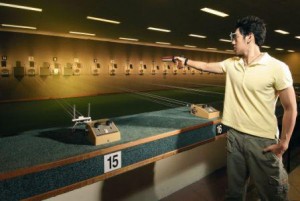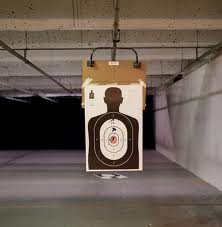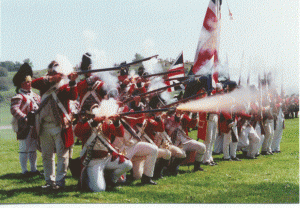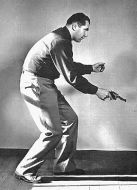 We normally equate snap shots with photography; a record of a split-second moment of time usually taken at an ISO setting of 400 for most of us. For the firearm’s operator; however, the term “snap shot” takes on a completely different meaning although similarities are present.
We normally equate snap shots with photography; a record of a split-second moment of time usually taken at an ISO setting of 400 for most of us. For the firearm’s operator; however, the term “snap shot” takes on a completely different meaning although similarities are present.
I was at the range recently and watched a young couple that was shooting in the lane next to mine. The target, set at a distance that I would call “Face Slapping” was being filled with random holes of the unlearned.
The young man, taking his time to line up the sights, was doing everything wrong that you could possibly call wrong; poor trigger control, poor grip, poor posture, etc. When he actually did hit the target, he would turn to his companion and smile. Like most of us; though, he was starting somewhere but he really needed some shooting lessons and a lot more practice.
I got to thinking later about how sighting systems on firearms have progressed through the ages. Early firearms had no sights and one would simply look down the barrel. Later, as sights were developed, we learned to use them as an aid to provide accurate fire. The fact remained; however, that we used the sights rather than rely on instinctive shooting because of the relative accuracy they provided.
“Ready, aim, fire” were words commonplace to military operations, as soldiers lined up in rows and were prepared to give “volleys” of fire. When it came down to UCAP (Up Close And Personal) combat, the sights became relatively useless and the soldier was forced to simply point-n-shoot. Unlike today’s firearms, the “Spray and Pray” technique (shoot many times without aiming; you are bound to hit something) was non-existent, as only one shot could be fired at a time.Time moves forward and so did the advancement in firearms and shooting techniques for them. The “snap shot” was probably born out of necessity. He who got the round(s) off more quickly and accurately went home that night.
“Snap shooting” is shooting quickly and without taking deliberate aim with the sights. This includes shooting from the hip, shooting while moving, shooting from awkward positions, etc. It is also known as “instinctive shooting’ and “combat shooting” and “point shooting.” A shooting skill does not come naturally for most and has to be developed.
Colonel Rex Applegate (June 21, 1914–July 14, 1998) modernized snap shooting. Applegate was a proponent of the combat pistol shooting system outlined in “Kill or Get Killed”; based on point shooting with a strong emphasis on training for close-range, fast-response shooting. Jeff Cooper ((May 10, 1920 – September 25, 2006), a Marine Corp Lieutenant Colonel, is considered the father of modern handgun shooting by many. The five elements of the modern technique are:- A large caliber pistol, preferably a semi-auto
- The Weaver stance
- The presentation
- The flash sight picture
- The compressed surprise trigger break
Although Applegate’s method and Cooper’s were different, there ran one common thread; the flash sight picture.
There was one person faster than the famous Jerry Miculek – Bill Jordan (1911–1997). Bill had been one of the fast-draw experts who had instructed James Arness (TV’s Marshal Matt Dillon of Gunsmoke) on the finer points of getting a single-action Colt into battery quickly and accurately. Jordan’s .28-second time has since been bested by fast-draw aficionado Jerry Miculek. The, there is Bob Munden, whose exploits with the fast draw are becoming legendary.
Today, we have folks like Massad Ayoob and others whose teachings are founded on those principles developed by Applegate and Cooper with emphasis on modern combat and weaponry. The need to learn how to shoot instinctively is no greater today than in the past. It can make the difference between being killed and going home to your family.
 An eight-inch paper/metal target at 7 yards, 15 yards, 25, yards and 100 yards or longer is still an eight-inch target. You can take whatever amount of time it needs to strike that target with a single bullet or multiple bullets. These targets; however, are static; they do not shoot back and they do not rush at you with a blunt or sharpened weapon. This fact alone necessitates the need to learn and develop instinctive shooting – with or without using a flash sight picture.
An eight-inch paper/metal target at 7 yards, 15 yards, 25, yards and 100 yards or longer is still an eight-inch target. You can take whatever amount of time it needs to strike that target with a single bullet or multiple bullets. These targets; however, are static; they do not shoot back and they do not rush at you with a blunt or sharpened weapon. This fact alone necessitates the need to learn and develop instinctive shooting – with or without using a flash sight picture.
 I usually end my time at the range with instinctive shooting of sort – one handed, two-handed, right and left sides. I reserve one target for this last set of exercises. Sometimes I try to get a flash sight pictures and sometimes I just try to hit what I am looking at without using the sights. I am not going to tell you that I can shoot sub-moa groups doing so and insult your intelligence. I am going to tell you that I keep practicing these techniques in the hope that I never have to use them and also to develop them because I just might have to use them.
I usually end my time at the range with instinctive shooting of sort – one handed, two-handed, right and left sides. I reserve one target for this last set of exercises. Sometimes I try to get a flash sight pictures and sometimes I just try to hit what I am looking at without using the sights. I am not going to tell you that I can shoot sub-moa groups doing so and insult your intelligence. I am going to tell you that I keep practicing these techniques in the hope that I never have to use them and also to develop them because I just might have to use them.
Sources:
http://www.bobtuley.com/pointshooting.htm
http://en.wikipedia.org/wiki/Rex_Applegate
https://en.wikipedia.org/wiki/Jeff_Cooper
http://en.wikipedia.org/wiki/Bill_Jordan_%28Marine%29
http://www.darkcanyon.net/A%20Visit%20With%20Bill%20Jordan.htm
http://www.usacarry.com/instinctive-shooting/
http://en.wikipedia.org/wiki/Point_shooting
![]()



